Executive Intelligence – Book Review
Author: Justin Menkes
“In today’s workplace, an individual cannot become a star executive without possessing a set of business ‘smarts’ called executive intelligence”. “Smart” in different contexts could be positively viewed as well as negatively viewed. In either case, there is a reference to uncommon wisdom in problem-solving or decision-making. These people have a solution-driven mindset.
To illustrate, a truck was jammed underneath a highway overpass. This was causing long traffic behind. A frustrated driver walked forward to check what was happening. After receiving an explanation of how difficult it had been trying to remove the truck, that “that the bridge was not high enough”. The driver looked at it and responded by saying that it seemed that “the truck was not low enough”. The policeman did not get it. The man repeated himself and explained further what he meant, that reducing the air out of the tyres to free the truck would do the trick. And it did – that was it! The traffic was soon cleared.
This executive intelligence must be demonstrated clearly in three different areas:
1. Accomplishment of tasks – a strong task sense and juggling of priorities efficiently within timelines, set goals, and vision. To have the capacity to clearly decipher distractions or unnecessary detailing if not needed.
-
- Working with and through other people – people are the problem, people are the solution! So says a phrase. This is a fact that good leaders must accept, use and understand deeply. These are soft skills, implying emotional intelligence – EQ, is different from intelligence quotient – IQ. Leadership is understanding basic human nature and developing an effective philosophy in handling different personalities individually and collectively. Ignoring building a happy and dependable team is a personal risk.
- Judging oneself and adapting one’s behaviour accordingly – continuous and sincere self-appraisal, Self-discovery, and self-management skills are things effective leaders do often. Good leaders self-evaluate frequently and very frequently want feedback on decisions made. He is smart enough not to assume he should always have the final word but always knows where he is going.
Executive intelligence thus does not consist of a single ability or isolated skill. Rather, it is a blend of critical aptitudes that guides an individual’s decision-making process and behavioral path. Thus, you may find many specialists not being good leaders of large teams – an engineer or a doctor may be very good on the job, but not in leadership. This has its roots in critical thinking. This is also different from abstract logic or reasoning, these wild thoughts or theorizing in the air – thoughts that cannot be domiciled. Some brilliant people are distracted by this kind of thinking – such thoughts are often too idealistic to be on the ground.
A good knowledge base is very good but not all that is needed. We have also seen some not-so-educated very successful in managing their businesses to unbelievable heights – INNOSON MOTORS is a critical example!
Views: 4

 The “management” category groups together articles relating to leadership and administrative topics
The “management” category groups together articles relating to leadership and administrative topics